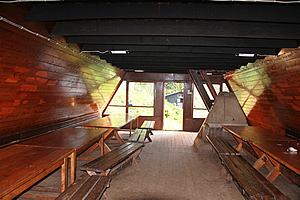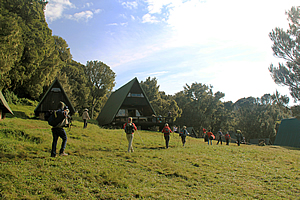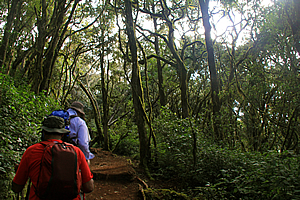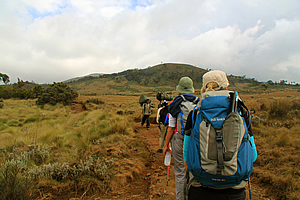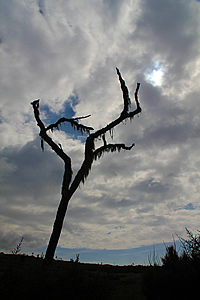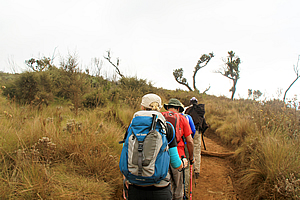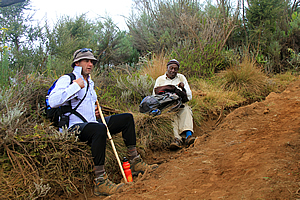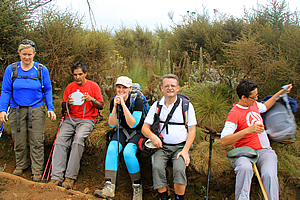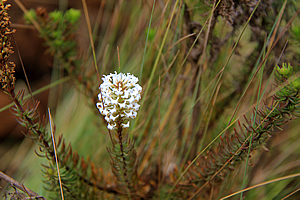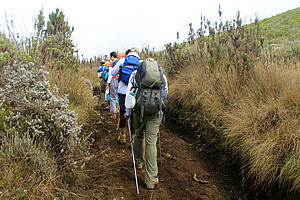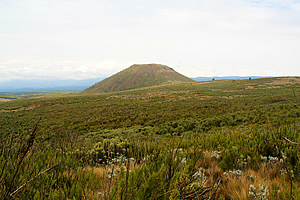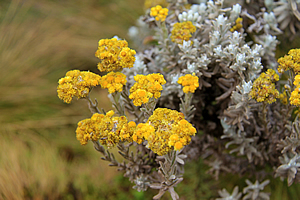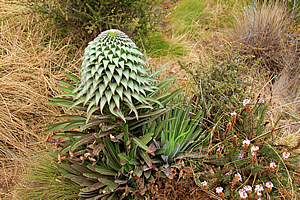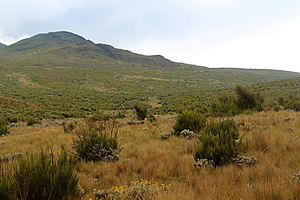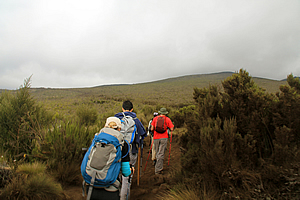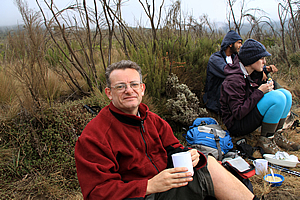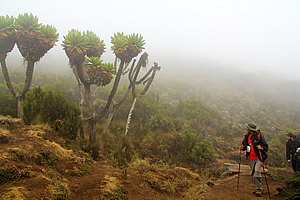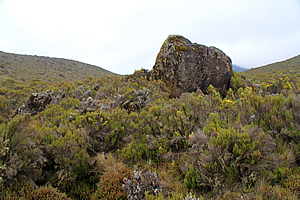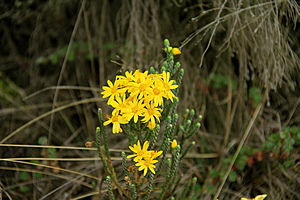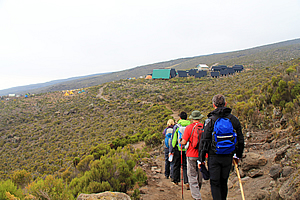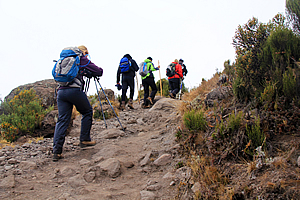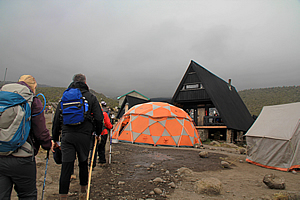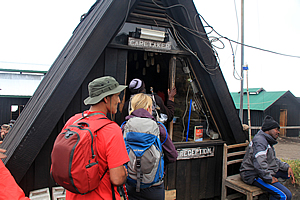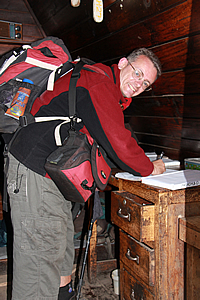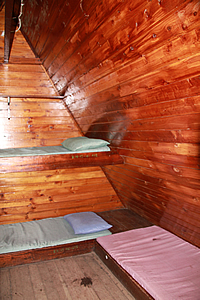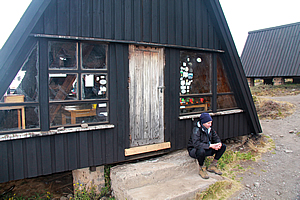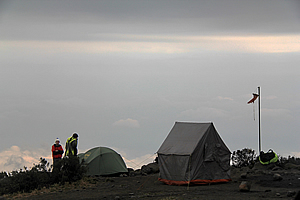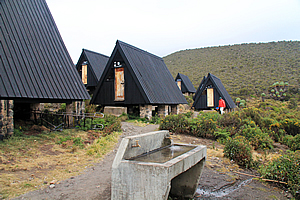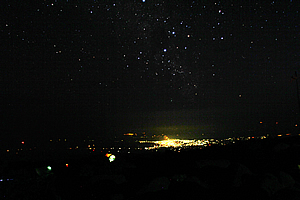|
||||||||||||||||||||||||||||||||||||||||||||||||||||||||||||||||||||||
|
||||||||||||||||||||||||||||||||||||||||||||||||||||||||||||||||||||||
Home > Treks > Outside Australasia > Mount Kilimanjaro > 4 |
||||||||||||||||||||||||||||||||||||||||||||||||||||||||||||||||||||||
|
||||||||||||||||||||||||||||||||||||||||||||||||||||||||||||||||||||||
Introduction to today's journeyOne may walk over the highest mountain one step at at time. - Barbara Walters Today's trek continues out of Mandara moderately climbing through heathland scrub gaining 1000 metres of altitude up to the village at Horombo Huts. Today's JourneyDistance trekked today: 12 kilometres. Total distance trekked to date: 24 kilometres. HAVING strange dreams is one of the symptoms of high altitude. Well I definitely had a few strange dreams during my first night on Kilimanjaro. I can’t recall them now, but they were really weird. It was very chilly when I woke up in the early morning. I had slept huddled in my sleeping bag, but I didn’t have my blanket on over the top of me, so I felt rather cold when I woke up. I crawled out and got dressed. Jono rolled over complaining he hadn’t slept at all thanks to how short his bed had been on the upper level bunk of the A frame hut. Salesman Mark started talking as soon as he woke up. Then came the knock at the door. I recalled the ritual from the Inca trail. Sure enough our guides Jaseri, Azaan and Imara were outside with bowls of warm water and soap for washing ourselves. They also had cups of tea.
Now I never drink tea at below two thousand metres above sea level. Here at two thousand seven hundred metres, I obliged, with two spoons of sugar as I had done in the Inca trail – the rule was one spoon full rounded down for every thousand metres of altitude. This morning it was brilliantly sunny outside which was a nice change from the perpetual cloud I’ve seen overhead since leaving Dubai a week ago now. The grass was a little frosty. No wonder it felt so cold. Then I realised that if there was a frost here, then how cold is it going to be further up the mountain? We had a thousand metres to climb today, and another thousand tomorrow, then finally a further twelve hundred the next night. One thousand metres altitude gain equates to six degrees drop in temperature. That would make the summit about nineteen degrees cooler than here. If I was already feeling it down here, it is going to awfully awfully cold at the top!
Jono was very surprised that I was finding it cold up here, rather curtly saying that where he comes from in Canada the temperature often drops to below minus thirty in winter. I on the other hand live in the subtropics. Mark seemed in a fantastic mood today, singing “we’re going on a jet plane”. Jono got annoyed at him, but Mark said the song came from the days when flying was considered a real luxury and romance. These days everyone did it so the novelty wasn’t the same now as when the song was written. With that explained, he continued singing it. Perhaps he was thinking climbing a large mountain was a luxury in this day and age. I collected my large water bladder and took it up to the hut for the porters to fill. We all assembled at our table which had already been set for us. The honeymooners Levi and Rachel joined us.
Hekima the cook produced a large metal pot full of porridge, which to be honest I couldn’t stand. Then a couple of porters served us a small banana, some papaya and some watermelon. There was also plenty to drink. There were four thermoses as there had been yesterday - two had hot milk and the others had hot water. The hot milk was no doubt made from powder. Ashley was celebrating her thirty second birthday today, so the cook, guides and porters came together at breakfast in the large dining tent and sung her a Swahili birthday song. It was nothing too amazing, but we spent the breakfast celebrating with what we had. There was also a large bowl of cornflakes, which I tried with the hot milk (there was no cold milk). That was disgusting. Thankfully there were some hot sausages and other food to eat.
Once we finished eating, we went outside and collected our water bladders and bottles the porters had by now filled and sitting on the outside table. We also picked up a lunch box each from the same table, and packed up ready for today’s hiking as another fairly large group departed leading the way for us. Putting on our day packs, we left our main packs in the hut. No doubt my pack will be a little heavier now with the overnight dampness. We went outside to below the dining hut where Jaseri and the other Azaan and Imara were already waiting. They were all rugged up in thick jackets and woolly hats. It was rather cold, but I didn’t think it was that cold.
We left the hut going through the final stretch of cloud forest where monkeys were rummaging around in the trees just above our heads. A thin haze enveloped us and when we were out of the thick bush, it was overcast with a thin layer of high cloud above us. At least sunburn wasn’t going to be a big problem today. My legs were very stiff from the climb to the waterfall gully the other day. This was the second day out and usually pain is worst then, so I hoped the pain would start to start to subside from now on. We walked through the heath scrub, soon passing the junction where we had turned off to explore Maundi Crater. Jono was walking directly behind me and persistently spitting. He told me that it was an unfortunate manifestation of an allergic reaction he had the other day. Now that made sense to me, and made me a bit more tolerant of it.
Polé polé – we were taking it very slowly following Jaseri’s painfully slow lead as all the porters quickly overtook us, seemingly not giving any thought to the potential of getting altitude sickness. They were incredibly strong, all of very good muscular stature. They carried their huge loads on their heads balancing them with their hands. This seemed very unnatural to me with all that weight on their heads. At least their spines would be straight through and not leading forward as one experiences whilst carrying a back pack.
Whenever each porter passed us they advertised quite strongly that deodorant seems to be in short supply here in Africa, and to make matters worse, it seems that Africans are the smelliest people on the planet. You could smell them approaching and the thick stench of their body odour would linger long after they passed. As they would pass us, we would mutter “Jambo” to each other. Jambo is the Swahili word for “Hello”. I recalled in New Zealand whenever we would pass someone on the trail we would briefly mutter “hello” then press on knowing we would never see each other again. The connection was just for a brief second. I recalled the climb I did in Hokkaido. It was not “hello”, but “konnichiwa”, the Japanese word for Hello. Here it was “Jambo”. We continued walking through the alpine heath. The soil we walked on was dusty very dark greyish brown volcanic dust with the odd bit of cut grass trampled into it. The scrub spreading out from either side of the track was getting more scattered and shortening. Fast porters were coming the other way now, descending from the hut we were heading towards. They will be coming off the mountain today, carrying the supplies of other groups who may or may not have made it up to the summit.
Reaching the summit was now off my radar. Firstly I couldn’t see it through the clouds above me. Anyway the goal I had to focus on was hiking a thousand vertical metres to a hut at about the same altitude as New Zealand’s highest mountain. At this altitude I will be sleeping higher than I had ever slept before. Today’s goal was enough without thinking any further ahead. The porters were coming down the track thick and fast now, all of smelt ripe. Most of them were men, but there was the odd female porter as well. I had never seen female porters before – certainly not on Mount Kinabalu or on the Inca Trail. The female porters I saw here were incredibly well built, though still feminine looking despite labouring under the heavy loads they carried upon their heads.
We reached a small bend in the track under the shade of some scrubby trees. Not that we needed shade as the cloud cover that had suddenly appeared shortly after passing the Maundy Crater was thickening above us. We were at about three thousand metres now and the terrain wasn’t very steep at all. We were climbing up a very long and wide ridge, perhaps the enlargement of a gentle knoll. The terrain steepened above us to a large round hill summiting about a thousand metres above us. There was another one further in the distance poking up into the thickening cloud cover. Later I would discover this was Mawenzi Peak, Africa’s third highest summit. We stopped here and had a quick rest in amongst the almost leafless trees. I sat next to Vicky who was wearing and showing off her high tech Macpac lyrcas, making the rest of us look scruffy. She obviously wasn’t very experienced at climbing, as she had gone out and bought the latest gear. In my experience the seasoned hikers tend to look rather scruffy showing the character of all the war stories they had been through.
Much to my horror I suddenly saw a cigarette butt on the track in front of me. I had seen a few more coming up the track. How on earth could anyone smoke up here in the oxygen deprived environment? I recalled that all of the porters and guides on Mount Kinabalu were smokers, but they never smoked on the trail. I had never seen any cigarette butts on the Mount Kinabalu track, or on the Inca Trail. I’ve always had a thing that you know you are on a good track when there are no cigarette butts. The disgusting smokers are obviously not fit enough to hike such tracks and ruin the tranquillity of the natural environment with their disgusting personal habits. So why was it different up here? Were they from the locals or from the tourists? Either way further depriving yourself of oxygen at this altitude would be suicide. Once rested, we got up and continued hiking polé polé up the gentle grade. To our left down the slope was a large obvious dome crater, probably a dike volcano hundreds of thousands of years old. The height of the scrub was now below our heads, giving us for the first time a clear view in all directions. We could just see back to Marangu through the distance. Interesting alpine plants appeared through the yellow tussock. The tussock was endemic to the mountain as would many other species be. We were on a sky island now – an area where the vegetation was isolated from the rest of the world. In this case the forest we had climbed through yesterday between Marangu and Mandara would be isolating these plants from the rest of the world, giving them the opportunity to evolve independently. This was creating species that would be found nowhere else in the world.
I had already been to a couple of sky islands. The first was Mount Taranaki, a similar but much steeper volcano under which I was born. There were numerous species growing there that could not be found anywhere else in New Zealand. That hadn’t even compared to Mount Kinabalu though, with many species of all kinds of plants and even some animals that are not found anywhere else on Earth. Being perhaps the most bio diverse sky island in the world, this one didn’t even compare, but it was still nice to be on a sky island that had its own unique ecosystem.
The track suddenly steepened and we found ourselves now climbing up soft dried fine soil – very much like peat. It was very soft and dusty – thankfully it hadn’t been raining up here otherwise it would be rather muddy here. For the first time I was glad we were going so slow as it was hard work climbing up the soft peat in the high altitude. Then I heard the clunking of mattocks. There were a few people ahead who were working the track, improving it for future travellers. It was hard going walking up there over the now uneven surface, but it would have been very hard for them to be digging away at the bank and ground shaping the track.
We plodded past very slowly as tourists began to pass us along with more smelly porters. They were going a lot faster than we were, and the smell of the porters mixed in with the dust we were all kicking up was getting unbearable. Finally we were atop the small ridge and the track evened up, giving us some much needed respite. The alpine plants on either side of the track were amazing now. They had very interesting tiny flowers on them. Most plants now were either tussock grasses or they had very small leaves on them, testament to the very harsh cold climate up here. It was very similar to the alpine vegetation I had seen in New Zealand.
The soft dusty peat suddenly became thick yellow brown scoria which we crunched through once again. The track was now rather uneven with the rocks protruding through. The large volcanic cone we had passed at the last rest place was now growing distant behind us and we were nearly level with its summit. We were now starting to wind in and out of the gullies as the terrain here was quite a bit steeper at about twenty degrees. It was still very gentle by mountain standards, but a lot steeper than it had been up till now. Fortunately the track didn’t steepen. Instead it just wound between tiny ridge and gully.
We rounded the main ridge below the hill above us now a lot closer, and saw the mountain went on and on and on for many kilometres. The cloud was covering the tops now at just a few hundred metres above us. It was hard to imagine what the mountain would look like above. It seemed the hills were all starting to level off as they approached the cloud cover. It wasn’t the classic volcano shape where the gradient increases with altitude. This was evident of erosion of an aged volcano. The summit area hasn’t erupted in around three hundred thousand years, and I guessed it would have been at least a million years since this area has seen activity.
Upon reaching the top of the ridge we decided to rest for a few minutes. Looking at the view Gary made the comment that this was a huge mountain. It seemed to be bigger than the whole of Banks Peninsula, a cluster of extinct volcanoes, near Christchurch. There we saw the first specimens of the unusual plant that only grows up here. It was the tallest tree and appeared to be something that came out of a time before the dinosaurs. This was one of the species of giant groundsels – the Dendrosenecio Kilimajari, endemic to this mountain. There were similar species of giant groundsel in other high mountains around equatorial Africa, but this one was unique to here. This small tree has large leaf rosettes where the leaves develop in large buds. They store water in the pith of the stem. This water forms an ice nucleating polysaccharide fluid, a natural form of antifreeze allowing them to survive at these altitudes.
We continued walking around the ridge along fairly level terrain under the big hill before it started to steepen again. The temperature was getting noticeably cold. That was to be expected. We were climbing a kilometre per day and one kilometre of altitude equals about six degrees drop in temperature. Soon the ridge was over and the track became steeper with scoria rock again. The clouds were getting lower. Another layer of cloud had covered the lowlands below us. We were in the region between the low cloud and the mid-level cloud.
In the distance at the top of the gentle ridge section we saw a leaning long drop toilet on the side of the track. We walked to just past the toilet and sat down for a lunch break. We pulled out our lunch boxes and ate. Once again my green orange was very sour, and I couldn’t eat it. Everything else got devoured though. Thankfully I still had my appetite. Loss of appetite is meant to be a major symptom of altitude sickness. The porters gave us a mug each and poured hot tea into the cups. I was over three thousand five hundred metres above sea level now. According to my rule of drinking tea, I had three sugars. It was very sweet, but gave me the energy boost I needed.
We were finishing lunch when cold drizzle started falling from the dark cloud. We quickly put on our raincoats, shouldered our bags and continued walking. Within five minutes we saw cloud over the track just ahead of us, and a minute later we were immersed in the cocoon of the grey fog of the mid-level alto nimbus clouds. The mist silently billowed through the small gullies. We were now crossing small bridges over each gully indicating water runs down here during flooding
We hadn’t seen any natural running water since the middle of the forest far below us. I recalled from the volcanoes I had climbed in New Zealand the rock on these mountains was very porous, so the water would just seep into the rock and come out in springs near the bottom of the mountain. The volcanoes of the North Island are very young though. This mountain hasn’t had a significant eruption in over three hundred thousand years. Was that long enough to start plugging in all the leakages? Then we reached a deeper than normal gully which did have a stream of running water running through it. The vegetation on either side of the gully was very interesting, all sorts of small leaf alpine plant. The large strange dendrosenecio kilimanjari was very abundant in the valleys now.
We crossed over another low spur and entered another gully with running water. The cloud started lifting, removing the translucent greyness. The rain stopped falling. The cloud completely lifted, and I looked back. The large crater that had seemed huge at our first resting place was just a tiny truncated cone in the far distance. We stopped for another rest. There were a lot of interesting primitive mosses in the undergrowth around here. The tussock was a lot lower and thinner, and there were still a lot of bright white and yellow flowers from different alpine plants.
We got up just as another group reached us, so we were mixed in with them for a while as we crossed a large bridge over a big escarpment bigger than the other gullies we had crossed so far. We continued for another fifteen minutes before we reached the top of a rather steep bluff and saw a group of huts and tents up the next spur. This was Horombo – our goal for the day. The huts were all A-framed and coloured black. We descended fairly steeply into the next gully then back up the other side rather steeply up the gravely scoria. Horombo was a much larger camp than Mandara. This is because people stay here going both up and down the mountain. Mandara is only used for people staying on their way up the mountain. In addition to this, many people going up the mountain stay here for two nights to acclimatise. The huts here can accommodate up to one hundred and twenty people.
A large dome tent dominated our view before the huts. It was covered with a tessellation of orange and grey triangles. It would have belonged to a group of porters. Behind the tent stood two large dining huts. Each dining hut was a little bigger than the one at Mandara. Behind that were the A framed huts where people stayed. They were the same size as the ones at Mandara. We turned to the left of the dining huts to head towards the hut where we sign in. On the way up was a sign which I posed behind. It said “Welcome to Horombo Huts, Alt 3720 MASL. I was just thirty metres short of the altitude of Mount Cook, New Zealand’s highest mountain. This will be the highest altitude I have ever slept apart from the two nights I had spent in Puno on the shores of Lake Titicaca where I was about a hundred metres higher – but I wasn’t trekking at the time, so that didn’t count.
We reached a small hut with a small sign saying “Caretaker” above the door. That was an interesting office with a very long commute. We queued and entered the small reception and signed in. Ashley had a photo taken of her writing that she was 31 for the first time ever. In a couple of days’ time I can start writing 40 for my age. We looked back down the ridge. There was a ledge just past where we had come up where a group of tents was pitched beneath a blown out wind sock. So they land helicopters up here for rescues. Nearby was an array of solar panels with about fifteen car batteries underneath. This must be our power supply. My legs were still a little sore from the waterfall the other day, but thankfully they were finally starting to feel better.
I saw a porter wheeling a strange wheelbarrow. I had seen one of these at Mandara, but didn’t take much notice of it. It had a wooden frame with handles at either end about two metres long and half a metre wide. A single wheel was attached to the bottom of it raising it nearly a metre above the ground. The porter was wheeling it. Jaseri told us this was a stretcher. People who needed to be carried off the mountain would be wheeled down the trail on that. To me that was a very precarious way to travel. If I were to injure myself then I’d much rather walk. Spending a day or two on one of these wheelbarrow stretchers would be torture. We were allocated our huts, both next to each other behind the upper dining hall. Hopefully people won’t be too noisy there tonight. There was a strong smell of old used machinery oil. That explained why these huts were black. They had been painted with a layer of machine oil. I wondered how that helped them. There was a very steep set of two concrete steps up to the entrance. These huts were sitting on tall piles of stone columns nearly a metre off the ground. It was very hard climbing those steps at such high altitude with sore legs. Once inside the hut it was exactly the same as the huts in Mandara.
|
||||||||||||||||||||||||||||||||||||||||||||||||||||||||||||||||||||||
Inside the A-framed hut |
Jaseri gave us the key to the padlock of the door. Hopefully we were going to be a bit more successful in keeping the door locked this afternoon than we had yesterday.
A communal dining hut |
I took the bed behind the door as I had done last night. That had worked well for me, so why not. To my surprise Jono took the top bunk again. Will he sleep tonight after his complaints this morning? Mark took the bunk below Jono and Gary came in our hut tonight. He obviously didn’t like staying with the girls last night. They had their own hut.
We put out our beds and walked down to the far dining hut. On the way there we discovered a concrete cow trough with a tap running a small trickle of water into it. The water was very cold. It was used for washing up no doubt. We entered one of the two dining huts for afternoon tea where we were served popcorn, peanuts and biscuits.
Looking down the mountain |
Following afternoon tea, I returned outside to explore the camp. Large boulders were scattered with alpine plants growing in whatever shelter they could find. The rest of the area was either huts or bare soil worn down by many boots.
Up the hill was a rather modern looking toilet block. I needed to go so I went up to the block where to my surprise there were modern flush toilets and running water. This was a big improvement on the filthy squat toilets at Mandara and the disgusting long drop toilets along the track.
The water supply trough |
The hut had a small florescent light in it. There was a small paper notice of basic rules written in poor English, posted on 9 October 1995 – sixteen years ago! The notice was in surprisingly good condition.
It was still overcast here, but the sun had come out further down the mountain over the conical peak now far below us.
We eventually returned to the main hut where dinner was being prepared. There was white ducting leading to light bulb fittings with light bulbs in them this time. There was obviously a solar powered lighting system set up here and still working.
|
Levi and Rachel joined us. This was the last time we were going to be having a meal together as they were going to be staying here an extra night, and had every intention of sleeping in as much as possible tomorrow.
Dinner was served – firstly a very nice vegetable soup. We ate it quickly before it got cold as the porters lit a couple of candles on the table. It was freezing in here and we were all wearing our woollen hats. Then they served us a nice lasagne with some steaks and vegetables. That made for a very hearty meal.
The dining room was full of quite a lot of people. Most were people who were on their way up the mountain, but some were people who had successfully reached the summit early this morning. They were obviously elated by their achievement, but also rather exhausted from their long fourteen hour day.
|
It was completely dark outside by the time dinner was finished. Thankfully the lights were working. The others stayed in the warmth of the dining hut whilst I returned to the hut, got the tripod out, deciding to put it to good use, then set the camera up below the huts.
The sky had cleared. The stars were brighter than I had ever seen them before. That made sense as we were over forty percent of the dirty layer normally encountered at low altitudes. Here the air was perfectly clean. Far below were the lights of a town. The stars appeared enormous and very bright from way up here. This definitely was the brightest I had ever seen them. I had seen them from Laban Rata on Mount Kinabalu, but that was about four hundred metres lower than this. All the nights on the Inca Trail had been overcast, so I had not been able to see the stars at all from there.
View of Moshe and the stars above |
I experimented with a bit of photography. Unfortunately you can’t have long exposures otherwise the pinpoint stars become streaks, and that assume the tripod stays still.
Finally I returned to the room and went to bed. We were all exhausted, so we quickly fell asleep to Mark still singing the “We’re going on a jet plane” song he had been singing on and off since waking up this morning. Perhaps this was his way of expressing his altitude sickness symptoms.
| Home | Photography | Diary | Travels | Treks | |
© 2001-2020 walkaboutjeff.com - Copyright - Disclaimer - Who is Walkabout Jeff? |

